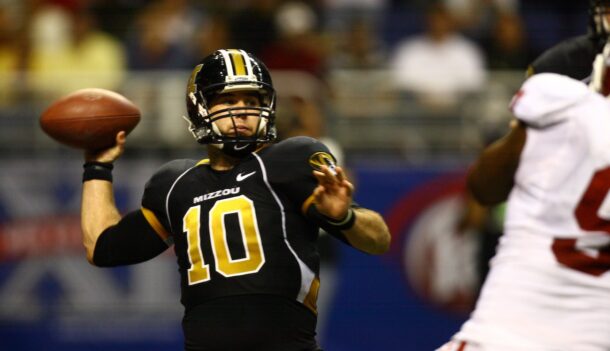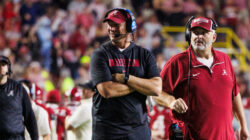Forget the notion that the old-school blocking back no longer has a place in the game. Auburn needs to find a good one in a bad way.
Even if the Tigers lean toward the pass more than we’re used to seeing from coach Gus Malzahn, expect the team to run the ball well more than the majority of offensive snaps. And, other than a quarterback who makes good decisions at the mesh point, is there any more important piece within Auburn’s read-option than the team’s H-back?
Jay Prosch wasn’t a household name in 2013, but he graded at better than 92 percent every game, according to the Dothan Eagle. In other words, Auburn could count on him to execute his assignment every single play. But not only did Prosch always head to the right spot on the field, he demolished whomever stood in his way.
So many times in ’13, the gap that got action from Nick Marshall or Tre Mason could be predicted based on where Prosch went after the snap. What looked like a read-option many times was a play designed to follow a 256-pound plow.
The team’s running game missed Prosch last season. Brandon Fulse, his replacement, saw between 20 and 50 snaps at the role in ’14, depending on the opponent. Tight end C.J. Uzomah played a handful of snaps per game at H-back as well. Overall, though, the duo couldn’t match Prosch’s knack for the position and physically weren’t as natural for H-back. Fulse spend much of his career previously as an in-line blocking tight end and didn’t have experience in the backfield.
Auburn is in great position to upgrade at H-back in ’15. The outlook at running back for Kamryn Pettway, a redshirt freshman, didn’t appear strong with such a crowded backfield. He’s added about 20 pounds since he signed with the team as a three-star member of the 2014 class, and he’s spent spring practice cross-training at H-back and tight end.
His prospects for contributing this fall have gotten much higher with the tweak in role.
“Kamryn is so athletic. For a big guy, he’s very athletic,” Auburn offensive coordinator Lashlee said, according to the Dothan Eagle. “He’s light on his feet. He’s very physical and I think he’s got a chance to really help us there. He’s transitioning well so far.”
Pettway is the early leader — he resembles Prosch physically much closer than last year’s H-backs — but the Tigers seemed to recruit Chandler Cox specifically for this role. The four-star early enrollee rated as the No. 2 fullback in the country, according to 247Sports, behind LSU signee David Ducre.
Cox arrived on The Plains at 6-foot-1 and 225 pounds, so he’s 20 pounds lighter than Pettway and about 30 pounds lighter than Prosch was in ’13. He should add weight between now and the season, but how much? Will he be big enough to blast through the hole full speed and stop SEC middle linebackers in their tracks?
Both Pettway and Cox have experience in the backfield, which seems to be the best formula. Prosch, for instance, started as a fullback at Illinois before transitioning to H-back at Auburn.
“You know, we’ve done it before,” Lashlee said. “I don’t know if it’s necessarily easier, but sometimes you get bigger backs with more short-yardage type backs that have the size and the physicality to do it. I don’t know if it’s easier, but we’ve had success with it.”
Whomever gets the majority of snaps at Auburn’s H-back position will enter the season still needing to grow into the role, learning the nuances of the offense, and perhaps physically as well in the case of Cox. Auburn fans can’t expect a Prosch clone Sept. 5 against Louisville. Neither has played in a college game yet.
The possibility exists that the team could begin to utilize its H-back as more than a lead blocker. Both Pettway and Cox are versatile athletes who can catch passes out of the backfield or carry the ball in short-yardage situations. Auburn rarely has thrown to the H-back under Malzahn, but the coach has shown a willingness to adapt his offense to his personnel.
One of these players very well could be the next Prosch. Each of them could still be playing the position for Auburn in 2018.
The Tigers also have had to replace two strong, talented pieces on the offensive line the last two years in left tackle Greg Robinson and center Reese Dismukes. Auburn always is going to have players in the backfield capable of leveraging good run-blocking, but this spring is crucial to replenish the team’s elite blocking talent.
With a little patience, Auburn soon could return to fielding one of the best, most physical group of blockers in the SEC once again.
An itinerant journalist, Christopher has moved between states 11 times in seven years. Formally an injury-prone Division I 800-meter specialist, he now wanders the Rockies in search of high peaks.







